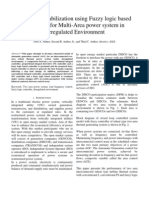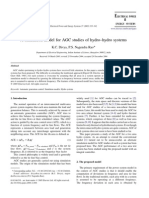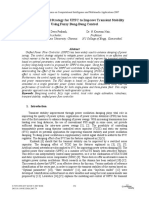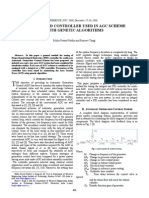AA310107
AA310107
Uploaded by
Tania JohnsonCopyright:
Available Formats
AA310107
AA310107
Uploaded by
Tania JohnsonCopyright
Available Formats
Share this document
Did you find this document useful?
Is this content inappropriate?
Copyright:
Available Formats
AA310107
AA310107
Uploaded by
Tania JohnsonCopyright:
Available Formats
International Journal of Modern Engineering Research (IJMER)
www.ijmer.com Vol.3, Issue.1, Jan.-Feb. 2013 pp-01-07 ISSN: 2249-6645
www.ijmer.com 1 | Page
Er. Dipayan Guha,
1
Prof. (Dr.) T. K. Sengupta
2
1Final Year Student, Electrical Engineering (M.Tech) Department, Asansol Engineering College, West Bengal, India
2Campus Director, Suprem Knowledge Foundation Group of Institution, Mankundu, Hooghly, West Bengal, India
Abstract: In the present work, we focus on the study of dynamic behavior of an interconnected two-area power system and
a scheme for improvement of response for the same. Here, two-area system with one non-reheat thermal units & one reheat
thermal units is considered. The frequency and tie-line power deviation of two units are studied using MATLAB-SIMULINK
in continuous time domain and also in discrete time domain. The paper focus on the study of frequency & tie-line power
deviation for step load changes of 1% in both areas with conventional Proportional-Integral control and improvement in
dynamic performances while replaced with discrete controller.
Keywords: Automatic Generation Control, Modeling of Interconnected Power system, Dynamic performance study of both
the areas, MATLAB SIMULINK.
I. INTRODUCTION
Now-a-days, modern power systems are divided into number of areas. For example, in our country, eastern grid, western
grid etc. and each area are interconnected among themselves through transmission lines, called tie-line.
Interconnected power system or power grid provides following advantages over the control area operated individually,
i. It stabilizes the grid which in turn increases stability, reliability & security of the overall system.
ii. Maintaining frequency to a fixed value which reduces voltage collapse & chances of undesirable load-shed situation.
Earlier days, one generating unit in a system would be designed as the regulated unit & it was manually adjusted to
Control the balance between the net generation & load demand. But now with automatic Generation system, many units are
participated in regulation, improving overall system efficiency & economy.
The main function of power system operation and control is to provide continuous power supply to all consumers
connected to it. Automatic Load frequency control (ALFC) or Automatic Generation control (AGC) regulates real power
flow between different control areas while keeping frequency constant.
The main features of ALFC loops are
i. Keeping frequency to its steady state value.
ii. To control power flow between interconnected control areas.
iii. Maintain equal load distribution among the participating units.
Tie-line bias is carefully monitored & represented for all tie-lines. Bias is the accepted standard operating constraint
that controls the area control error (ACE), monitoring & adjusting tie-line flows to keep the system stable. Stability is the
term to describe how far a power grid handles a system disturbances or power system fault.
The main objective of the present work is to perform a comparative study of dynamic response of interconnected
power system with reheat & non-reheat type turbines and also an improvement for dynamic performance of inter-connected
power system after replacing the PI controller with discrete PI controller.
II. SYSTEM INVESTIGATED
The MW frequency or ALFC system investigated comprises an interconnected power system of two-area (a) non-reheat
control area-1 & (b) reheat control area-2,shown in fig:(1). The nominal values of the parameters are given in appendix 2.
Dynamic Response Analysis of Automatic Generation Control in a 2-
Area (Reheat & Non-Reheat) Interconnected Power System and a
Scheme for Improvement of Response for the Same
International Journal of Modern Engineering Research (IJMER)
www.ijmer.com Vol.3, Issue.1, Jan.-Feb. 2013 pp-01-07 ISSN: 2249-6645
www.ijmer.com 2 | Page
III. MODELING OF DESIRED POWER SYSTEM
The continuous time dynamics behavior of the AGC system is described by the linear vector differential equations
For formulating the state space model, output of all blocks having either integrator or a time constant assumed to be state
variable
[7]
.
State space models of single area system with above assumption of reheat & non-reheat thermal units are given below,
respectively
Whereas, state space model of our concerned interconnected power system is defined as, calculations are given in appendix
1.
A =
(
(
(
(
(
(
(
(
(
(
(
(
(
(
(
(
(
(
(
(
(
(
(
|
|
.
|
\
|
0 0 0 0 0 0 0 0
0 0 1 0 0 0 0 0 0
0 0 0 0 0 0 2 0 0 2
0 0 0
1
0 0
1
0 0 0
0 0 0
1 1
0 0 0 0 0
0 0 0
1 1
0 0 0 0
0 0 0 0
1
0 0 0
0 0 0 0 0 0 0
1
0
1
0 0 0 0 0 0 0
1 1
0
0 0 0 0 0 0 0
1
12 2
1
12 12
2 2 2
2 2
2 2
2
2 12
2
2
2
1 1 1
1 1
1
1
1
1
1
a b
b
T T
T T R
T T
T
k
T
k
T T
T
k a
T
k
T
T T R
T T
T
k
T
k
T
sg sg
t t
t
r
t
r
r r
ps
ps
ps
ps
ps
sg sg
t t
ps
ps
ps
ps
ps
t t
B =
T
sg
sg
T
T
(
(
(
(
0 0 0
1
0 0 0 0 0 0
0 0 0 0 0 0 0
1
0 0
2
1
G=
T
ps
ps
ps
ps
T
K
T
K
(
(
(
(
0 0 0 0 0 0 0 0 0
0 0 0 0 0 0 0 0 0
2
2
1
1
International Journal of Modern Engineering Research (IJMER)
www.ijmer.com Vol.3, Issue.1, Jan.-Feb. 2013 pp-01-07 ISSN: 2249-6645
www.ijmer.com 3 | Page
IV. SIMULINK RESULT
Dynamic response of single area system for both reheat & non-reheat type thermal system shown in fig(2).
Fig(2) Dynamic response of single area system
- Minimization of steady state error:
It is observed from fig: (2) that the system has pronounced steady state error of e
SS
= 51.89% (-ve). There are number of
methods available to reduce steady state error, here we used conventional PI-controller, since the implementation of PI-
controller is very easy.
Effect of PI-controller to reheat & non-reheat single area system shown in fig: (3).
Fig:(3) Dynamic response of single area system with PI-controller
Fig: (4) to fig: (7) depict f
1
(t), f
2
(t), P
tie,12
(t) & P
tie,21
(t) responses in continuous time domain using SIMULINK.
In the present study, we divided our result into three cases:
Case1: Continuous time domain analysis of interconnected power system without any controller & frequency bias setting.
Case2: Continuous time domain analysis of interconnected power system with PI-controller of K
i
= 0.4 & frequency bias
setting, B
i
= 0.
Case3: Continuous time domain analysis of interconnected power system with PI-controller of K
i
= 0.4 & frequency bias
setting, B
i
= 0.425.
Fig:(4) Frequency deviation of two-area system with B
i
=0 & K
i
=0
International Journal of Modern Engineering Research (IJMER)
www.ijmer.com Vol.3, Issue.1, Jan.-Feb. 2013 pp-01-07 ISSN: 2249-6645
www.ijmer.com 4 | Page
Fig:(5) Frequency deviation of two-area system with B
i
=0 & K
i
=0.4
Fig: (6) Frequency deviation of two-area system with B
i
=0.425 & K
i
=0.4
Fig(7) Tie-line power deviation of two area system with B
i
= 0.425 & K
i
= 0.4
V. OBSERVATION
In this paper, the interconnected two-area power system theory is studied with SIMULINK in continuous domain.
The frequency & tie-line power deviation have been observed for the same system.
Following points are observed from the SIMULINK results-
1. Both single area & two-area systems are non-minimum phase system, which exhibits a high undershoot near at the
origin, fig.(2).
2. By observation of fig.(2) & fig.(3), the steady state error is reduced using conventional PI-controller but it has no effect
on transient response of the system.
3. By observation of fig.(3), settling time of Non Reheat thermal & Reheat thermal system are, respectively, 7sec &
11sec, approximately, which shows that reheat system has sluggish dynamic response compare to non-reheat system.
International Journal of Modern Engineering Research (IJMER)
www.ijmer.com Vol.3, Issue.1, Jan.-Feb. 2013 pp-01-07 ISSN: 2249-6645
www.ijmer.com 5 | Page
4. In comparison to the single area system interconnected power system has less no. of oscillation that make the system
more stable, refer to fig.(6).
5. In fig.(5), the system has high peak overshoot which is highly minimized with proper choice of frequency bias
constraint, B
i
as shown in fig.(6).
6. It is observed from fig.(7) that tie-line power flow deviates from nominal setting, with sudden load changes in both the
area and it takes 10-12 sec to settle down.
7. From the investigation carried out in this paper, it is relevant that PI-controller strategy offers ameliorated system
dynamic performance compared to P-controller.
VI. DEVELOPMENT / MODIFICATION SUGGESTED
To improve the sluggish response of the reheat cycle area, we suggest the following improvement to be done
1. This paper is completely based on the study of dynamic performance of the system in CT domain. But if the same
study is done in DT domain, by discretezition of controller signal further improvement of dynamic response is
possible. Under figure shows the suggested model
Fig: (8) Proposed block diagram in discrete medium
Fig: (9) Frequency deviation of two area system with B
i
= 0.425 & K
i
= 0.4 in Discrete domain
Fig: (10) Frequency deviation of two area system with B
i
= 0.425 & K
i
= 0.4 in Discrete domain
International Journal of Modern Engineering Research (IJMER)
www.ijmer.com Vol.3, Issue.1, Jan.-Feb. 2013 pp-01-07 ISSN: 2249-6645
www.ijmer.com 6 | Page
Fig: (9) & (10) shows frequency deviation of interconnected power system with two different sampling times. It is
observed that if sampling rate is made high then dynamic response analysis gives good result as long as system stability
retained.
2. This paper completely focused on the study of conventional PI controller which exhibits poor dynamic performance
due to parameters variation and other controller exhibits poor dynamic response due to parameter variation and other
system uncertainties. If, PI controller replaced by some intelligent controllers, like based on Fuzzy logic theory,
optimal controller theory etc, then again further improvement of system response is possible.
VII. CONCLUSION
With the advent of new regulation, (2003 electricity act) distributed & dispersed system generation are
recommended and performed for National Power development. One of the main reasons India should be able to achieve a
smooth transition from fossil fuel economy to sustainable renewable energy based economy for sustainable development
which compiles
(i) Energy for all
(ii) Energy for ever
(iii) For equitable
(iv) Environment friendly
If above is available and possible we must have a control area where some units will be having non-reheat turbine (smaller
area) and other areas (bigger area) of reheat type. Hence, this paper suggests discretization of the control area for better
control of system frequency & tie-line power flow.
Appendix-1
International Journal of Modern Engineering Research (IJMER)
www.ijmer.com Vol.3, Issue.1, Jan.-Feb. 2013 pp-01-07 ISSN: 2249-6645
www.ijmer.com 7 | Page
Appendix-2
Numerical data -
Sl.
No.
Notations Full name Numerical
value
1 i Subscript referring to
area i (i=1,2)
-
2 Pr
i
Rating of i-th generator
in MW
2000
3 T
t
(or T
CH
) Turbine time constant
in sec
0.3 sec
4 T
sg
Time constant speed
governor in sec
0.08 sec
5
K
PS
, T
PS
Time constant & gain
of power system,
respectively
120, 20 sec
respectively
6
K
r
,T
r
Reheat coefficient &
time constant ,
respectively
0.5, 10 sec
respectively
7 T
12
Synchronizing
coefficient
t 2
545 . 0
8
R
i
Governor speed
regulation parameter in
Hz per p.u. MW
4 . 2
1
9 P
tie
Incremental change in
tie-line power
-
10
F
i
Incremental change in
frequency deviation
-
11 P
Di
Incremental change in
load demand
-
12
P
Ci
Incremental change in
speed governor
position
-
13 Y
Ei
Incremental change in
valve position
-
14
D
Load frequency
constant in p.u MW per
Hz (P
D
/f)
-
15 B
i
Frequency bias
constant
0.425
16
Nominal phase angle of
voltages
(
12
=
1
2
)
-
17 K
ii
Integration time
constant
0.4
References
[1] Prof J Nanda, Dr. M L Kothari, Sample data AGC of Hydro-Thermal system considering GRC, IEEE-trans., September 25, 1989
[2] Prof. C S Indulkar, Analysis of MW frequency control problem using sampled data theory, IEEE trans., January 1, 1992.
[3] Prof. Prabhat Kumar, Ibraheem, Dynamic performance evaluation of 2-area interconnected power system a comparative study,
IEEE-trans, August 14, 1996.
[4] Dr. T.K.Sengupta, Studies on assessment of power frequency in interconnected grid its computer based control & protection,
2008, thesis paper in JU.
[5] Elegerd, O.l., Eletric energy system theory an introduction, second edition, Tata McGraw Hill.
[6] Grainger, J, William,J & Stevenson, Jr - Power system analysis edition 2003, Tata McGraw Hill.
[7] Kothari, D.P, & Nagrath, I.J., Power system Engineering, second edition, Tata McGraw Hill.
You might also like
- Problem StatementDocument9 pagesProblem StatementTauseef Gillani100% (1)
- Vol.3 Issue1Document600 pagesVol.3 Issue1mc_salubreNo ratings yet
- Load Frequency Control of Hydro and Nuclear Power System by PI & GA ControllerDocument6 pagesLoad Frequency Control of Hydro and Nuclear Power System by PI & GA Controllerijsret100% (1)
- Ijeet 06 08 005Document10 pagesIjeet 06 08 005IAEME PublicationNo ratings yet
- DynamicProjectArticle PDFDocument9 pagesDynamicProjectArticle PDFNeha JainNo ratings yet
- Frequency Stabilization Using Fuzzy Logic Based Controller For Multi-Area Power System in Deregulated EnvironmentDocument10 pagesFrequency Stabilization Using Fuzzy Logic Based Controller For Multi-Area Power System in Deregulated Environmentyogi_sikarNo ratings yet
- Frequency-Bias Tie-Line Control of Hydroelectric Generating Stations For Long DistancesDocument5 pagesFrequency-Bias Tie-Line Control of Hydroelectric Generating Stations For Long DistancesShashank MandloiNo ratings yet
- Design and Analysis of TID Controller For Load Frequency Control of Two-Area Interconnected Power SystemDocument5 pagesDesign and Analysis of TID Controller For Load Frequency Control of Two-Area Interconnected Power SystemGuru MishraNo ratings yet
- AGC Modelado Simulación IndiaDocument11 pagesAGC Modelado Simulación IndiacastrojpNo ratings yet
- Journal of Electrical EngineeringDocument16 pagesJournal of Electrical EngineeringkodandaramNo ratings yet
- An Adaptive Protection Algorithm For Distribution Systems With Distributed GenerationDocument7 pagesAn Adaptive Protection Algorithm For Distribution Systems With Distributed GenerationJamile_P_NNo ratings yet
- Fuzzy Logic For Single AreaDocument11 pagesFuzzy Logic For Single Areaabata yohannesNo ratings yet
- Design and Analysis of An Adaptive Fuzzy Power System StabilizerDocument7 pagesDesign and Analysis of An Adaptive Fuzzy Power System StabilizermiguelankeloNo ratings yet
- Load Frequency Control in Three Area Power System Using Fuzzy Logic ControllerDocument6 pagesLoad Frequency Control in Three Area Power System Using Fuzzy Logic ControllerEditor IJTSRDNo ratings yet
- UPFC Control Based On New IP Type Controller: Mojtaba Shirvani, Babak Keyvani, Mostafa Abdollahi and Ahmad MemaripourDocument8 pagesUPFC Control Based On New IP Type Controller: Mojtaba Shirvani, Babak Keyvani, Mostafa Abdollahi and Ahmad MemaripourMmillion AlemayehuNo ratings yet
- Study of Transient Angle Stability in Microgrids With Synchronous Generation Through Comparative Analysis of Operating ScenariosDocument18 pagesStudy of Transient Angle Stability in Microgrids With Synchronous Generation Through Comparative Analysis of Operating Scenariosipazmino2353No ratings yet
- Bacterial Foraging Optimization Based Load Frequency Control of Interconnected Power Systems With Static Synchronous Series CompensatorDocument7 pagesBacterial Foraging Optimization Based Load Frequency Control of Interconnected Power Systems With Static Synchronous Series CompensatorSahitya16No ratings yet
- Study On Series Compensated Load Frequency Oscillation in Two Area Power System Using Pid & Fuzzy Logic ControllersDocument11 pagesStudy On Series Compensated Load Frequency Oscillation in Two Area Power System Using Pid & Fuzzy Logic Controllersashiq2023meleep002No ratings yet
- Facts Based Controller For Interconnected Hydrothermal Power SystemDocument11 pagesFacts Based Controller For Interconnected Hydrothermal Power Systemnuzi62No ratings yet
- Design of Model Predictive Controller (MPC) For Load Frequency Control (LFC) in An Interconnected Power SystemDocument9 pagesDesign of Model Predictive Controller (MPC) For Load Frequency Control (LFC) in An Interconnected Power SystemAmberMeerabNo ratings yet
- Robust Power System Stabilizer Design For An Industrial Power System in Taiwan Using Linear Matrix Inequality TechniquesDocument6 pagesRobust Power System Stabilizer Design For An Industrial Power System in Taiwan Using Linear Matrix Inequality TechniquesDiego Martinez AranedaNo ratings yet
- Small Signal Stability of A Large Power System As Affected by New Generation Additions by Prabha KundurDocument5 pagesSmall Signal Stability of A Large Power System As Affected by New Generation Additions by Prabha KundurAuspiciousNo ratings yet
- International Journal of Computational Engineering Research (IJCER)Document5 pagesInternational Journal of Computational Engineering Research (IJCER)International Journal of computational Engineering research (IJCER)No ratings yet
- A Simulation Model For AGC Studies of Hydro-Hydro SystemsDocument8 pagesA Simulation Model For AGC Studies of Hydro-Hydro SystemssaikrishnavelichetiNo ratings yet
- Two Area Power SystemDocument9 pagesTwo Area Power SystemMaths Side100% (1)
- Automatic Load Frequency Control of Multi-Area Power System Using ANN Controller and Genetic AlgorithmDocument8 pagesAutomatic Load Frequency Control of Multi-Area Power System Using ANN Controller and Genetic Algorithmseventhsensegroup100% (1)
- Simulation of Grid Connected PV System With PI, fuzzy-GA Based Controllers For Power Flow ControlDocument9 pagesSimulation of Grid Connected PV System With PI, fuzzy-GA Based Controllers For Power Flow ControlInternational Journal of Power Electronics and Drive SystemsNo ratings yet
- Carga Frecuencia USADocument8 pagesCarga Frecuencia USAcastrojpNo ratings yet
- Load Frequency Control in Two Area Power System Using ANFISDocument10 pagesLoad Frequency Control in Two Area Power System Using ANFISSudhir Kumar100% (1)
- 2 PDFDocument5 pages2 PDFvireshmathadNo ratings yet
- Fuzzy Logic Based Automatic Generation Control of Interconnected Power System IJERTCONV4IS15012Document5 pagesFuzzy Logic Based Automatic Generation Control of Interconnected Power System IJERTCONV4IS15012bhargavkoriya837No ratings yet
- A Robust Control Strategy For UPFC To Improve Transient Stability Using Fuzzy Bang-Bang ControlDocument5 pagesA Robust Control Strategy For UPFC To Improve Transient Stability Using Fuzzy Bang-Bang ControlXahid YousafNo ratings yet
- Load Frequency Control of Interconnected Hydro-Thermal Power System Using Conventional PI and Fuzzy Logic ControllerDocument7 pagesLoad Frequency Control of Interconnected Hydro-Thermal Power System Using Conventional PI and Fuzzy Logic ControllerBbbNo ratings yet
- Voltage Stability Improvement by Using SVC With Fuzzy Logic Controller-224 PDFDocument6 pagesVoltage Stability Improvement by Using SVC With Fuzzy Logic Controller-224 PDFhailekahNo ratings yet
- 2015 Leelavathi-RajuDocument7 pages2015 Leelavathi-RajuRaju KuruvaNo ratings yet
- Tuning of Pid Controller Used in Agc Scheme With Genetic AlgorithmsDocument6 pagesTuning of Pid Controller Used in Agc Scheme With Genetic Algorithmsjjm_8679641No ratings yet
- TUMMALA2018 Article ObserverBasedSlidingModeFrequeDocument9 pagesTUMMALA2018 Article ObserverBasedSlidingModeFrequeAR-TNo ratings yet
- Archive of SID: Dynamic Controllers Design For STATCOMDocument7 pagesArchive of SID: Dynamic Controllers Design For STATCOMRajaavikhram YohanandhanNo ratings yet
- Load Frequency Control of Interconnected Power System Grid Involving Wind and Hydropower Plant and Comparative AnalysisDocument12 pagesLoad Frequency Control of Interconnected Power System Grid Involving Wind and Hydropower Plant and Comparative AnalysisRadmila KolevaNo ratings yet
- Journalofelectricalengineering&Technologyvol.5, No.4, Pp.552 560,2010 ÎDocument14 pagesJournalofelectricalengineering&Technologyvol.5, No.4, Pp.552 560,2010 ÎgeethachowNo ratings yet
- Icreata21 Paper 37Document3 pagesIcreata21 Paper 37attouNo ratings yet
- A Robust Fuzzy Logic PI Controller For Solar System Battery ChargingDocument11 pagesA Robust Fuzzy Logic PI Controller For Solar System Battery ChargingInternational Journal of Power Electronics and Drive SystemsNo ratings yet
- Gwo ManuscriptDocument5 pagesGwo ManuscriptMahendra KumarNo ratings yet
- Design of Robust Type-2 Fuzzy Logic Power System Stabilizer Using Hopf BifurcationsDocument5 pagesDesign of Robust Type-2 Fuzzy Logic Power System Stabilizer Using Hopf BifurcationsijaertNo ratings yet
- Computer Aided Transient Stability AnalysisDocument5 pagesComputer Aided Transient Stability AnalysisViresh PatelNo ratings yet
- Control of Harmonics and Performance Analysis of A Grid Connected Photovoltaic SystemDocument9 pagesControl of Harmonics and Performance Analysis of A Grid Connected Photovoltaic SystemRanimSaifNo ratings yet
- Robust Control of A Single-Phase VSI With LCL Filter For Grid-Tie and Islanded Operation ModesDocument8 pagesRobust Control of A Single-Phase VSI With LCL Filter For Grid-Tie and Islanded Operation ModesJoseCarlosUgazNo ratings yet
- Inverter - Fault Current Contribution PDFDocument6 pagesInverter - Fault Current Contribution PDFbalaeee123No ratings yet
- A Robust Nonlinear Control Strategy of A PV System Connected To The Three-Phase Grid Based On Backstepping and PSO TechniqueDocument15 pagesA Robust Nonlinear Control Strategy of A PV System Connected To The Three-Phase Grid Based On Backstepping and PSO TechniqueInternational Journal of Power Electronics and Drive SystemsNo ratings yet
- Analysis On Various Optimization Techniques Used For Load Frequency Control in Power SystemDocument25 pagesAnalysis On Various Optimization Techniques Used For Load Frequency Control in Power SystemsuderNo ratings yet
- 1 s2.0 S0378779622008823 MainDocument17 pages1 s2.0 S0378779622008823 MainSouhila Rached ZINENo ratings yet
- Load-Frequency Control in A Two-Area Power System Using The Fuzzy PID MethodDocument23 pagesLoad-Frequency Control in A Two-Area Power System Using The Fuzzy PID MethodpetruskaraNo ratings yet
- Chapter 1Document46 pagesChapter 1Asish NandaNo ratings yet
- Automatic Generation Control With Fuzzy Logic Controllers in The Power System Including SMES UnitsDocument15 pagesAutomatic Generation Control With Fuzzy Logic Controllers in The Power System Including SMES UnitstejaNo ratings yet
- Design of Parallel 2-DOF PID Controller by Bee Algorithm For Interconnected Thermal Power SystemsDocument5 pagesDesign of Parallel 2-DOF PID Controller by Bee Algorithm For Interconnected Thermal Power Systemsharrypotter20132No ratings yet
- StatcomDocument6 pagesStatcomsathyakalyanNo ratings yet
- Modeling and Design of PV Grid Integration For GA-PSO Based On Fluctuating Power QualityDocument8 pagesModeling and Design of PV Grid Integration For GA-PSO Based On Fluctuating Power QualityInternational Journal of Power Electronics and Drive SystemsNo ratings yet
- 2260-Article Text-6805-1-10-20161113Document15 pages2260-Article Text-6805-1-10-20161113Nirav ChauhanNo ratings yet
- Tawfik 2015Document4 pagesTawfik 2015B.Kailash Krishna PrasadNo ratings yet
- Simulation of Some Power System, Control System and Power Electronics Case Studies Using Matlab and PowerWorld SimulatorFrom EverandSimulation of Some Power System, Control System and Power Electronics Case Studies Using Matlab and PowerWorld SimulatorNo ratings yet
- XML Based Reverse Engineering SystemDocument4 pagesXML Based Reverse Engineering SystemTania JohnsonNo ratings yet
- Breast Cancer Detection Using Histogram Based DecompositionDocument7 pagesBreast Cancer Detection Using Histogram Based DecompositionTania JohnsonNo ratings yet
- Invention of The Plane Geometrical Formulae-Part IDocument15 pagesInvention of The Plane Geometrical Formulae-Part ITania JohnsonNo ratings yet
- Privacy Preserving On Continuous and Discrete Data Sets - A Novel ApproachDocument7 pagesPrivacy Preserving On Continuous and Discrete Data Sets - A Novel ApproachTania JohnsonNo ratings yet
- The Mechanical Behaviour of Recycled High Density PolyethyleneDocument11 pagesThe Mechanical Behaviour of Recycled High Density PolyethyleneTania JohnsonNo ratings yet
































































